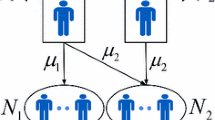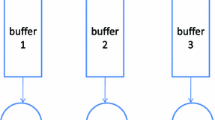Abstract
In complex systems, it is quite common to resort to approximations when optimizing system performance. These approximations typically involve selecting a particular system parameter and then studying the performance of the system as this parameter grows without bound. In such an asymptotic regime, we prove that if the approximation to the objective function is accurate up to \(\mathcal {O}(1)\), then under some regularity conditions, the prescriptions that are derived from this approximation are o(1)-optimal, i.e., their optimality gap is asymptotically zero. A consequence of this result is that the well-known square-root staffing rules for capacity sizing in M / M / s and \(M/M/s+M\) queues to minimize the sum of linear expected steady-state customer waiting costs and linear capacity costs are o(1)-optimal. We also discuss extensions of this result for the case of nonlinear customer waiting costs in these systems.
Similar content being viewed by others
Notes
For functions \(f:\mathbb {R}\rightarrow \mathbb {R}\) and \(g:\mathbb {R}\rightarrow \mathbb {R}_+\), we say that \(f(\lambda )=\mathcal {O}(g(\lambda ))\), if \(\limsup _{\lambda \rightarrow \infty } \frac{|f(\lambda )|}{g(\lambda )}<\infty \). Further, we say that \(f(\lambda )=o(g(\lambda ))\) if \(\lim _{\lambda \rightarrow \infty } \frac{f(\lambda )}{g(\lambda )}=0\).
References
Bassamboo, A., Randhawa, R.: On the accuracy of fluid models for capacity sizing in queueing systems with impatient customers. Oper. Res. 58(5), 1398–1413 (2010)
Borst, S., Mandelbaum, A., Reiman, M.I.: Dimensioning large call centers. Oper. Res. 52, 17–34 (2004)
Braverman, A., Dai, J.: Stein’s method for steady-state diffusion approximations of \(M/Ph/n+M\) systems. Working Paper, Cornell University (2015)
Chan, W.C., Lin, Y.B.: Waiting time distribution for the M/M/m queue. IEE Proc. Commun. 150(3), 159–162 (2003)
Garnett, O., Mandelbaum, A., Reiman, M.: Designing a call center with impatient customers. Manuf. Serv. Oper. Manag. 4(3), 208–227 (2002)
Grassmann, W.: The convexity of the mean queue size of the M/M/c queue with respect to the traffic intensity. J. Appl. Probab. 20, 916–919 (1983)
Gurvich, I.: Diffusion models and steady-state approximations for exponentially ergodic Markovian queues. Ann. Appl. Probab. 24(6), 2527–2559 (2014)
Halfin, S., Whitt, W.: Heavy-traffic limits for queues with many exponential servers. Oper. Res. 29, 567–588 (1981)
Harel, A.: Sharp bounds and simple approximations for the Erlang delay and loss formulas. Manag. Sci. 34(8), 959–972 (1988)
Harel, A.: Sharp and simple bounds for the Erlang delay and loss formulae. Queueing Syst. 64, 119–143 (2010)
Jagers, A., Van Doorn, E.A.: On the continued erlang loss function. Oper. Res. Lett. 5(1), 43–46 (1986)
Janssen, A., van Leeuwaarden, J., Zwart, B.: Refining square root safety staffing by expanding Erlang C. Oper. Res. 59(6), 1512–1522 (2011)
Kumar, S., Randhawa, R.: Exploiting market size in service systems. Manuf. Serv. Oper. Manag. 12(3), 511–526 (2010)
Zhang, B., van Leeuwaarden, J., Zwart, B.: Staffing call centers with impatient customers: refinements to many-server asymptotics. Oper. Res. 60(2), 461–474 (2012)
Author information
Authors and Affiliations
Corresponding author
Appendices
Appendix 1: Proof of Proposition 1
For the first part, we will establish that the third derivative of the expected steady-state queue-length with respect to the system utilization is positive for any fixed number of servers. We follow the argument in [6]. For convenience, we use \(L(\rho )\) to denote the expected number of customers in system in steady-state in the M / M / s system with arrival rate \(\lambda \), service rate \(\mu \), and utilization \(\rho =\frac{\lambda }{\mu s}\). Then, we have
where B is the probability that all servers are busy. Following [6], we can write the derivative of L with respect to \(\rho \) as
Using this relation, we can further differentiate both sides to obtain
Noting that \(\mathbb {E}Q_\lambda =L- s\rho \), we need to prove \(L'''>0\) to complete the proof.
We proceed by substituting the expressions for \(L''\) from (49) and that for \(L'\) from (48), and finally that for L from (47) into (50). This yields
To prove \(L'''>0\), we need to prove that \(Z(s,B)>0\). We will do so by proving \(\frac{\partial }{\partial n} Z(n,B)>0\) for \(1\le n\le s\) in Lemma 2, so that \(Z(s,B)\ge Z(1,B)\) and then, in Lemma 3, we will prove that \(Z(1,B)>0\) so that we obtain \(Z(s,B)>0\). This completes the proof of the first part of the result. We present the proof of the second part of the result after proving these lemmas.
Lemma 2
We have \(\frac{\partial }{\partial n} Z(n,B)>0\) for \(1\le n\le s\).
Proof
We proceed by computing
where
We need to prove that \(f(B)>0\). Straightforward algebra shows that \(c\ge 0\) for \(n\ge 1\), which gives us \(a,b,c\ge 0\) so that \(f(x)=0\) has two positive roots. We denote the smaller root by \(x_1:=\frac{b-\sqrt{b^2- 4a c}}{2a}\). To prove \(f(B)>0\), it suffices to prove that \(f'(B)<f'(x_1)\) because f is a convex quadratic function. We will in fact prove that \(f'(\bar{B})<f'(x_1)\), where \(\bar{B}\) is the following upper bound on B:
The bound (a) follows from the standard Erlang-C bound (cf. [9]), and (b) follows by noting that \(n\le s\). We next compute
Noting that \(f'(x_1),f'(\bar{B})<0\), we will prove that \(\frac{|f'(x_1)|}{\rho (1-\rho )}<\frac{|f'(\bar{B})|}{\rho (1-\rho )}\). Defining \(y=n(1-\rho )\), we can write
A straightforward calculation shows that \(\frac{\partial g}{\partial n}>0\). It follows that for any fixed y and \(n\ge 1\), \(g(y,n)\) is minimized at \(n=\max \{y,1\}\). Hence, for the case \(y \ge 1\), we can compute
If \(y\le 1\), then we use
Thus, we have proved that \(f(\bar{B})>0\), and because f is a quadratic decreasing function on \([0,\bar{B}]\), it follows that \(f(B)>0\) or equivalently \(\frac{\partial }{\partial n} Z(n,B) >0\) for \(1\le n\le s\). \(\square \)
Lemma 3
We have \(Z(1,B)>0\).
Proof
We have
Notice that
It is straightforward to establish that \(z''(x)>0\) for \(x\le \rho \) (notice that \(B\le \rho \) is a well known bound). Further, we have
It follows that \(z'(x)<0\) for all \(0\le x\le \rho \). Thus, we have
\(\square \)
We next prove that for any fixed offered load, the convexity of the expected queue-length with respect to the number of servers s is decreasing. We follow and extend the arguments in [10]. In particular, we follow the proof of Proposition 5 therein that establishes that the delay probability in an M / M / s queue (that we denote in this paper by \(B(\rho ,s)\)) is convex and decreasing in the number of servers s for any fixed offered load \(\lambda /\mu \). It will be convenient to use the terminology in that paper. In particular, we fix \(a=\lambda /\mu \) as the offered load and denote the delay probability by \(C_s:=B(a/s,s)\). Noting that the expected steady-state queue-length is given by
it follows that establishing our result is equivalent to proving that the delay probability \(C_s\) has the stated property that its convexity with respect to the number of servers is decreasing. [10] proves the convexity of the delay probability by establishing that the difference relation \(C_{s-1}+C_{s+1}-2C_s>0\) holds. To establish that the convexity is decreasing we prove that
As in [10], we write
Using these relations in (51) along with the relation \(a=\rho s\), we have
We next determine the sign of each of the denominators of the terms in the above relation. Using the property that \(\rho \ge C_s\) and that \(0\le C_x\le 1\) for \(s-1\le x\le s+2\), we can easily establish that
We next multiply the product of these three terms, which is positive, by the terms in (52). Thus, to establish our result, we need to prove that
The term on the left-hand-side of the above relation can be further simplified to
We next use the bound \(\frac{\rho }{s C_s}>\frac{(1-\rho )^2}{(1-C_s)^2}\) (as used in the convexity proof in [10]) and the additional bound \(C_s>1-(1-\rho )^2\sqrt{\pi s/8}\) (Eq. (17) in [10]) that holds for \(s\ge 3\), to establish that the term in (54) is positive (we omit the details for brevity). This completes the proof. \(\square \)
Appendix 2: Proof of Proposition 3
We first characterize the delay probability and then apply (34). We use Theorem 1 of [12], which gives us, for any \(\rho <1\),
where
We next focus on the number of servers \(s_\lambda =\frac{\lambda }{\mu }+\sigma \left( \frac{\lambda }{\mu } \right) ^{\frac{1}{r+1}} \). We add the subscript \(\lambda \) to the terms \(\rho ,\alpha ,\gamma \) to make the dependence on \(\lambda \) explicit. Notice that we can rewrite \(\gamma _\lambda \) as
Next consider \(\alpha _\lambda \). Applying Taylor series to \(\log \rho _\lambda =\log (1-(1-\rho _\lambda ))\), we obtain
Using this, we can express \(\alpha _\lambda \) as
Further, noting that \(\alpha _\lambda =o(1)\), we can apply Taylor series to \(\frac{\varPhi (\alpha _\lambda )}{\phi (\alpha _\lambda )}\) to obtain
Using (56), (57) and (58) in the upper bounding relation in (55), we obtain
Applying the Taylor series expansion to the first term on the right-hand-side of (59) gives us
Using the same arguments for the lower bounding relation in (55), we obtain
Combining (60) and (61), gives us
Thus, using (34), we obtain
where \(\epsilon _\lambda (\sigma )=\mathcal {O}(1)\). \(\square \)
Rights and permissions
About this article
Cite this article
Randhawa, R.S. Optimality gap of asymptotically derived prescriptions in queueing systems. Queueing Syst 83, 131–155 (2016). https://doi.org/10.1007/s11134-016-9476-z
Received:
Revised:
Published:
Issue Date:
DOI: https://doi.org/10.1007/s11134-016-9476-z




